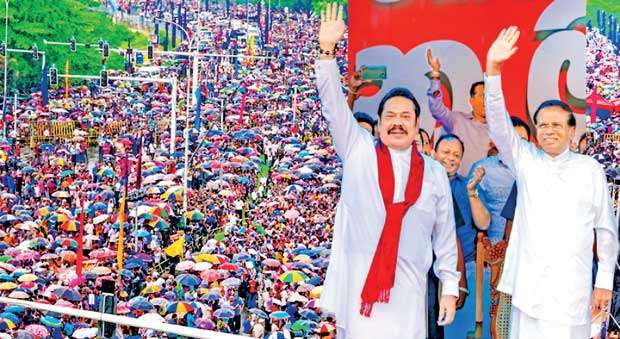Reply To:
Name - Reply Comment

 Sri Lanka’s experiment with hybrid governments failed miserably. By hybrid government, I mean a government that entails the President from one party and the administration or the Cabinet of ministers from another party (or a coalition).
Sri Lanka’s experiment with hybrid governments failed miserably. By hybrid government, I mean a government that entails the President from one party and the administration or the Cabinet of ministers from another party (or a coalition).
Under the Second Republican Constitution, the country had three hybrid governments: (1) Wijetunga -Kumaratunga administration, (2) Kumaratunga-Wickremesinghe administration, and (3) Sirisena – Wickremesinghe administration.
Hybrid governments
The first hybrid government was formed when Chandrika Kumaratunga, the rising star of the Sri Lanka Freedom Party (SLFP), won the August 1994 general election. Dingiri Banda Wijetunga of the United National Party (UNP) was the President. This government operated without any significant hiccups. Hence, one can argue that this part of the experiment was smooth and uncontroversial.
There were two main reasons why this government was unproblematic. One, it lasted only for about five months as Kumaratunga won the presidential election in November 1994. Two, Wijetunga was not an ambitious politician when he was President. It was Wijetunga’s lack of political ambition that influenced President Premadasa to make Wijetunga the Prime Minister. Premadasa did not want to opt for Lalith Athulathmudali or Gamini Dissanayake who were too ambitious and challenged Premadasa from within the party.
It is in the best interest of the President and the government to avoid hybrid administrations
Wijetunga was rather unexpectedly forced to accept the presidency when Premadasa was assassinated by the Liberation Tigers of Tamil Eelam (LTTE) in May 1993. Wijetunga did not contest the presidential election in 1994 either.
He allowed the nomination of Gamini Dissanayake, who was also killed during the campaign. The final contest was between Chandrika Kumaratunga and Sirima Dissanayake. Hence, Wijetunga did not have long-term political ambitions, which facilitated the smooth operation of the first hybrid government.
When the second hybrid government was formed, Kumaratunga was serving her second term as President. The United National Front headed by Ranil Wickremesinghe won the general election and formed the government in December 2001. The country expected what we then called ‘cohabitation’ between Kumaratunga and Wickremesinghe. This government which lasted for about two years was a mess.
The struggle between the President and the Prime Minister started even before the swearing in of the new government. Kumaratunga wanted to retain important portfolios such as the Ministry of Defense and opposed the inclusion of some ministers in the cabinet. For example, she did not want S.B. Dissanayake in the government. The President and the Prime Minister had vastly differing opinions about the peace talks with the LTTE and the ceasefire agreement signed in February 2002.
Kumaratunga who gradually started to take over government institutions from the control of the UNF, eventually reclaimed the ministries of Defense, Interior, and Mass Communication in November 2003. The Kumaratunga – Wickremesinghe government was terminated when the President prematurely dissolved Parliament in February 2004. Hence, this government represented constant confrontation rather than cohabitation.
The last experimentation was undertaken when Maithripala Sirisena and Ranil Wickremesinghe formed the government in September 2015. This should have been a relatively positive experience because they won elections with assistance from the same political alliance, although Sirisena was originally from the SLFP (and assumed leadership of the party as soon as he became President).
Despite the promise to serve only one term as president, Sirisena developed long-term political ambitions. Knowing very well that he cannot regain UNP votes in the next presidential election, he cooked up a political coup in collaboration with Mahinda Rajapaksa and dismissed Prime Minister Wickremesinghe from the office. The act pushed the country into a severe crisis. The crisis intensified when Parliament was dissolved in November 2018.
Eventually, the judiciary intervened to restore the status quo. However, there is no evidence to suggest that the problems between the government and the President have been resolved completely.
Abolishing Presidency
What is evident from the experiment with hybrid governments is that this mode of arrangement cannot work in Sri Lanka when both the President and the Prime Minister are politically active and ambitious. On the other hand, hardly any politician in Sri Lanka is unambitious. They do not retire too easily. They cling on to power.
Meanwhile, there is no guarantee that Sri Lankans will not produce hybrid governments in the future. People vote based on the day’s problems and expectations. They do not vote on future scenarios. They could be wrong even if they take into account future scenarios. Who would have expected Sirisena to fire Wickremesinghe given the nature of relations that existed between them in August 2015?
So, how do we avoid another hybrid problem? One option is to abolish the executive presidential system and to return to the Westminster model of governance. Abolishing the presidential system has been a long-standing political slogan of almost all major political entities in the South. Many of them have won elections based on this promise. Nevertheless, they were not sincere.
They like the ‘powers’ of the President. Hence, there has been an emotional attachment to the presidency among some political actors. Others have resisted the change on the belief that the return to the Westminster system would empower the minority political parties as they, most probably, have to be accommodated in a parliamentary form of government.
Hence, all major projects and proposals to change the system have already failed. Even attempts to water down the presidential powers through the 19th Amendment in 2015 faced stiff resistance.
The JVP’s proposal for the 20th Amendment has no takers. Therefore, it seems that resolving the hybrid issue by abolishing the executive presidential system will not work in the short-term.
Elections on the same day
The other option is to conduct both the presidential and general elections on the same day. In order to implement this option, the voter needs to be given two ballot papers to fill when they go to the polls. Sri Lankan people generally have firm political opinions. Hence, they are unlikely to vote one party for the President and another party for Parliament. In other words, a majority of the Sri Lankan voters will vote for the same party on both ballots, if both elections are held on the same day. This would ensure the same party (or coalition) governments. What we are talking about here are regular elections, not special elections created by unexpected circumstances.
This option entails several benefits. First, the country could avoid problems, especially instability caused by hybrid governments. Two, national elections are costly affairs in Sri Lanka. Combining the two most significant elections and conducting them on the same day could save an enormous amount of public resources.
Three, in the past, presidents have abused general elections to buttress their positions in Parliament. Presidents tend to conduct general elections when they suit their needs. This option could reduce presidential abuse of power at least marginally.
In order to implement this option, the country needs to make some serious decisions and introduce new legislation. Necessary legislation could be introduced with a simple majority in Parliament. In terms of decisions and legislation, the present government and the president need to be involved. The President and the government should understand the damage future hybrid governments could cause and act preemptively.
If conducting two elections on the same day is not acceptable, they should come up with other alternatives. It is in the best interest of the President and the government to avoid hybrid administrations.
Moreover, the voter needs to be educated on how to vote on two ballots. This will not be demanding. We had educated voters on new polling systems when the proportional representation system and the provincial council elections were introduced. The Election Commission could play a significant role in educating the voters. (Courtesy Eurasia Review)
(Dr. S. I. Keethaponcalan is Chair of the Conflict Resolution Department, Salisbury University, Maryland. Email: [email protected])